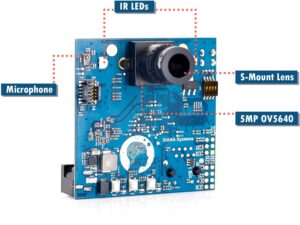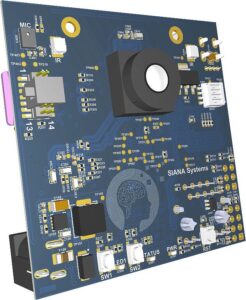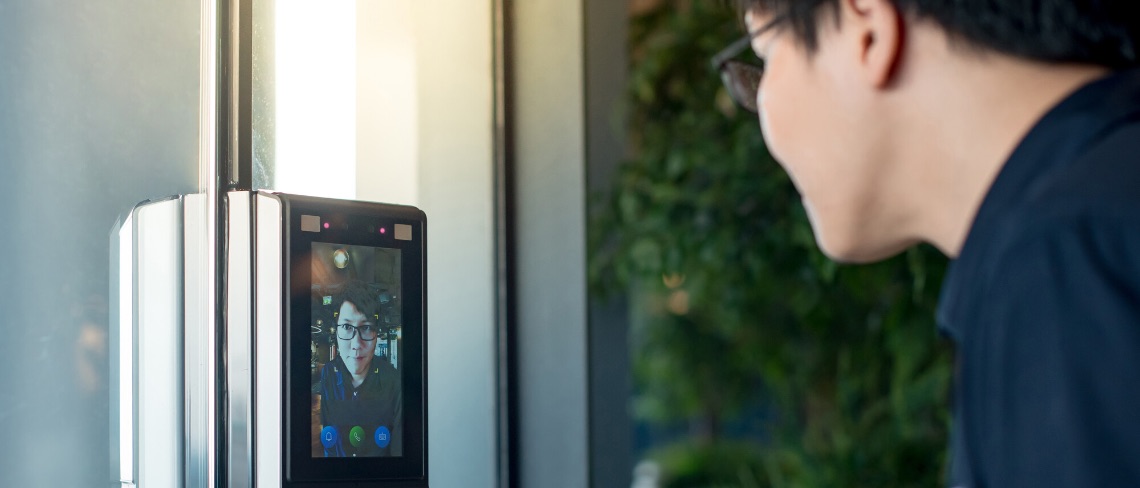The MPCam and MPTherm are two STM32MP1 development boards from Siana Systems, an ST Authorized Partner, that show why computer vision and machine learning at the edge are becoming mainstream. Both systems have similar specifications. They use the OSD32MP15x system-in-package from Octavo that we covered in a previous blog post. The model Siana chose contains 512 MB of DDR3. The boards also come with 4 GB of eMMC flash storing a bootable image, an SD card slot, an Ethernet port, USB host capabilities, and a 9 V connector for an external power adapter. The MPCam offers a 5-megapixel image sensor, while the MPTherm employs an 80 x 80 thermal sensor from Lynred.
MPCam and MPTherm, or the best entry point to computer vision
Why is Computer Vision Difficult?

Computer vision remains a complex technical problem to solve. Yet, more and more companies without engineering competencies want to benefit from it. Retail stores want to use people-tracking applications to improve operations while respecting customers’ privacy. Malls need better ways to monitor capacity, especially after a global pandemic. From social distancing detection to simple object recognition, computer vision is getting much more attention. Unfortunately, as Siana Systems shared, the problem is that roughly nine out of ten projects don’t make it out of the prototyping phase. Companies don’t know how to formulate what they need or understand what a commercial implementation demands. Hence, the solution is development boards that can bring managers back to reality.
What does computer vision look like?
One of the first challenges is understanding what a computer vision system looks like. MPCam and MPTherm thus help companies by directly putting a small PCB into the hands of developers and decision-makers that can quickly see what they are working with. It’s the reason why Siana chose to use Octavo’s SiP instead of doing everything from scratch. As the company shared, this approach represents a much faster time to market and a smaller PCB. Despite having the competencies, Siana wanted to focus on the application rather than tuning up the RAM, figuring out power management, and all the other technical implementations that a microprocessor requires.
Why build computer vision applications at the edge?
Companies also struggle with the application itself. Many don’t think of simply pushing video streams to the cloud but don’t realize the costs and infrastructure needed for this approach. For instance, a mall relying on its Wi-Fi network would rapidly see its traditional access points bogged down if it streamed multiple video channels all day. As a result, an edge device offering AI capabilities is often quintessential to a successful application. It’s why the MPCam and MPTherm use an STM32MP1 and a Coral, a tensor processing unit (TPU). Indeed, the system must be small but powerful enough to perform computations locally to alleviate bandwidth requirements.
How to build computer vision applications at the edge?

Even those that understand the need for AI at the edge may not realize what goes into a Linux operating system and how to create the necessary user experience to facilitate system management procedures, among other things. Consequently, the MPCam and MPTherm come with a bootable Linux image based on OpenSTLinux, an embedded Linux distribution. Moreover, Siana worked closely with ST to use our X-LINUX-AI software package, which helps run three demos out of the box. X-LINUX-AI supports Python 3.10, TensorFlow Lite 2.8.0, OpenCV 4.5, and more.
The frameworks enable Siana to provide image recognition and object detection applications. Moreover, the company also offers a proprietary people-tracking program in partnership with Stura.io. Tracking people is particularly finicky because it’s too easy to obtain faulty results by counting the same person multiple times or failing to monitor their movement. Indeed, it’s not enough to have the right hardware, OS, and framework. Each use case will demand new datasets, algorithms, and optimizations. By using OpenSTLinux and X-LINUX-AI, Siana helps customers get started. The MPCam and MPTherm ship with a web server. Customers can connect to it with a browser and begin running the demo applications in minutes.
How to popularize computer vision at the edge?
The boards from Siana represent a unique opportunity for companies that can experience computer vision without needing a data scientist in-house. The member of the ST Partner Program explains that it’s often the best way to help corporations determine if computer vision is right for them and what it would take to make it an operational reality. The final product is close to the final PCB layout, and Stura.io can help develop an application tailored to unique needs. By using an STM32MP1 SiP and ST’s software solutions, Siana demystified computer vision for companies with no technical expertise to ensure they could make the best decision for their business.
What are the deployment challenges?
The ST Authorized Partner is now looking to crack the next challenge: deployment. In many instances, installing boards is problematic, especially if the customer doesn’t have the technical know-how. Siana is thus working on kits to make field implementation easier. The design house is also closely paying attention to microcontrollers. Indeed, while the company doesn’t have any specifics in mind yet, it explained that it is increasingly working on embedded systems relying on an STM32H7 or STM32F7, and that the advancements in both UI framework and performance are pushing more and more projects to adopt MCUs. The member of the ST Partner Program is also a TouchGFX implementer for that very reason.
Siana and TouchGFX, or the future of embedded systems
What are the advantages of working with an STM32MP1?
While the MPCam and MPTherm exclusively use ST’s microprocessor, Siana shared that they’ve also been working on other projects that use STM32 microcontrollers and were early adopters of TouchGFX. It was thus interesting to learn how the company is working with MPUs and MCUs. Indeed, working with microprocessors and Linux makes designing user interfaces and experiences relatively straightforward. The company even has a UX expert specializing in graphic design rather than code development. By using a framework like Crank, another ST Partner Program member, designers don’t need expertise in code generation. It makes workflows easier and helps bridge communication with customers.
Why is TouchGFX increasingly popular?
Nevertheless, Siana also shared how they are witnessing similar trends on STM32 MCUs. Their teams rely heavily on the TouchGFX simulator, which enables them to work on designs with their graphical teams or customers without dealing with the codebase itself. The company also explained that performances on a device like the STM32H7 narrow the gap with microprocessors, enabling engineers to do more on microcontrollers. There are still noticeable differences in UI design between Linux and a real-time environment. Similarly, some applications require the power afforded by an MPU. We are not saying that they are interchangeable. Nonetheless, it is interesting that a design house with extensive expertise in Linux-based embedded systems is increasingly investing in TouchGFX and MCUs.
As computer vision at the edge becomes ubiquitous, we expect markets to gravitate toward more cost-effective solutions, which will inevitably include microcontrollers. And it is fascinating to see that the work our TouchGFX teams put in reducing friction and making our framework designer-friendly directly impacts the activities of a design house like Siana. If computer vision is already a reality, innovations like these will put edge devices everywhere. That’s also the lesson we drew at electronica 2022 as the MPCam was quite popular on the ST Booth.
